Silent Water Damage: 3 Things You Should Know About This Secretive (and Expensive) Damage
2/25/2020 (Permalink)
Severe water damage is mainly done over time. Water is a silent killer of your home foundations, furniture, air quality and anything else in it’s path (think of your finger tips when they’re in water too long!).
It is not so much about the water you can see, instead the water you don’t. After the visible water is cleared water remains in the cracks, crevices and underneath items, slowly eroding everything it touches. This is called Bound Water.
When looking at a house in Harrisville, WV our team noticed that there were multiple areas of water damage that had slowly built up over time. The family never had a flood or major water leak, instead it was gradual, small water leaking that had caused some major foundation damage.
Why Does Water Damage Building Foundations So Easily?
Water erodes dirt and soil under, around or in concrete and other materials in three main ways:
- Through movement - small, minor movements and friction slowly erodes the concrete (think about how crevices are carved in rocks from a stream of water).
- Through expansion - water expands within wooden foundations and furniture. By expanding within the wood, it breaks the wood apart, ruining is structural integrity.
- Through oxidation - As water comes into contact with metals (in the foundations, furniture or electrical equipment) it creates oxidisation, creating rust. Water doesn’t have to be a liquid. Even as condensation it can create rust in foundations and important household items.
How Do You Avoid This Silent Water Damage?
Prevention is always better (and cheaper) than cure. The earlier you catch issues, the better.
Create a routine of checking your basement and foundations. Perhaps every two weeks. This check will only take you a few minutes but could save you tens of thousands of dollars!
- Look for any leaks. e.g. plumbing fixtures and drains.
- Feel for any dampness around pipes and fixtures.
- Smell for any musty smells (indication of mold growing - therefore dampness)
If something catches your attention, find where the source of the water or dampness is coming from. If you can cut this off immediately (and safely) then do so and thoroughly clean up of all water you can see.
Had the family is Harrisville, WV known of this simple step they could have avoided costly repairs to the foundation and carpet replacement.
How Do You Fix Silent Water Damage?
It’s obvious to say: thorough water eradication is necessary. Water removal techniques include heat, air and sanitisation (don’t forget the potential for mold growth).
Silent water damage may require structural and foundation repairs as well as interior demolition and repairs. Common silent water damage normally consists of wood framing, drywall, insulation, trim, flooring and painting. It can also require exterior excavation and possibly pest control such as termite removal.
If you are unsure of any possible silent water damage please do not hesitate to call our team at SERVPRO on (304) 428 7378 and one of our technicians can assist you with further information.
We hope that this has helped.
Remember: set aside a few minutes bi-weekly to check for any silent water damage.
From the team at SERVPRO of Wood, Ritchie & Pleasants Counties




 24/7 Emergency Service
24/7 Emergency Service
